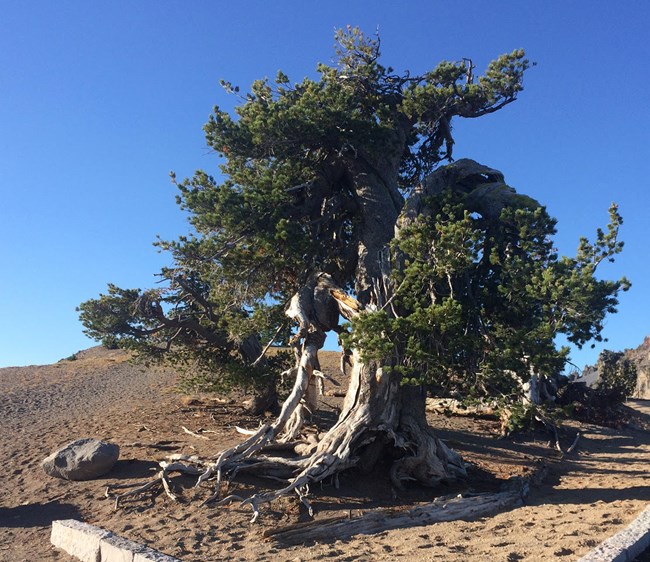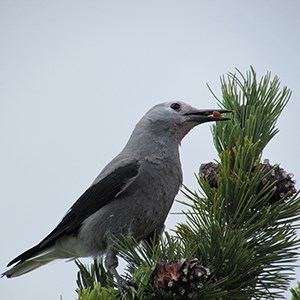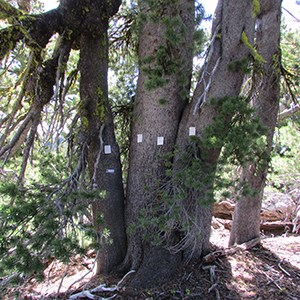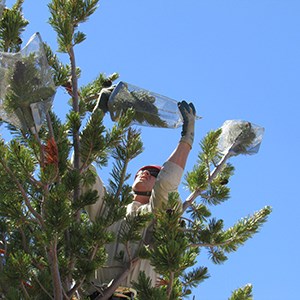
The seedlings of whitebark pine can tolerate full sun and are able to establish in previously tree-less areas, earning it the reputation of a colonizing or pioneer species. Once established, they improve and enhance harsh site conditions by facilitating the establishment of a diverse suite of subalpine plant and animal species. As a keystone tree, stands of whitebark pine serve important functional roles. They regulate snowmelt by shading and retaining snowpack, which also slows erosion by anchoring soils in place. 
Clark’s NutcrackerWhitebark pine shares a mutualistic, co-evolved relationship with the Clark’s nutcracker (Nucifraga columbiana). Whitebark pine is considered a “stone pine” because it bears cones that remain closed through maturity. The cones require animal assistance (typically from Clark’s nutcrackers – but also from squirrels, bears, and other mammals) to open cones and extract seeds. The Clark’s nutcracker stores whitebark pine seeds in “caches” for future food. The bird relies on a complex spatial memory to enable it to retrieve seeds at a later date. Un-recovered caches can develop into whitebark pine stands and woodlands.
White Pine Blister RustWhitebark pine have been declining within the park for decades. With the introduction of a non-native pathogen, Cronartium ribicola, to western North America in 1910, the disease white pine blister rust (WPBR) has developed. It has spread throughout the range of whitebark pine with devastating results. WPBR is progressive and fatal because few whitebark pines have genetic resistance to the disease.WPBR has five distinct stages. Two stages occur on trees as seen in photo to the right. The first image shows aecia—orange blisters which gave the disease its name. The blisters release powdery orange aeciospores that look like cheese-dust. The second image shows pycnia, spores in a sap-like fluid. The other three stages (not shown) occur on alternate hosts such as currants/gooseberries (Ribes sp.), Indian paintbrush (Castilleja sp.), and lousewort (Pedicularis sp.). The lifecycle of blister rust is very complex and may take four years to complete. 
Mountain Pine BeetleSimultaneously, warming temperatures and milder winters at high elevations facilitate prolonged outbreaks of the native, mountain pine beetle (MPB – Dendroctonus ponderosae). Adult beetles live through mild winters when otherwise the bitter cold would kill them. Their survival creates two cycles, rather than a single cycle of egg-laying adults. More beetles mean more larvae, which consume the phloem layer of trees, cutting off the flow of nutrients. Whitebark pine is more vulnerable to mountain pine beetle attack, and displays less resistance than other species.Information about the verbenone pouches (as seen in the photo) is located under conservation efforts below. 
Conservation EffortsIn 2003, park botanists applied the first actions in what would become a Whitebark Pine Conservation Program. Work began by implementing a whitebark pine long-term monitoring program, and by collecting cones from whitebark pine trees (see photo to right). Seedlings are grown from the collected cones, and tested for resistance to WPBR at the United States Forest Service, Dorena Genetic Resource Center.Crater Lake’s conservation program has expanded to include the planting of seedlings grown from rust-resistant “parent” trees, and annual monitoring of rust-resistant trees. Also, packets of verbenone, a bark beetle repellent, are tacked to whitebark pines that had their cones collected for rust-resistance screening (see photo above). All these efforts help to maintain healthy populations and grow new stands of this high-elevation keystone tree. In 2011, the United States Fish and Wildlife Service determined that listing whitebark pine as a threatened or endangered species was warranted but precluded by higher priority work. Whitebark pine remains a candidate species for the Endangered Species Act. MoreSince 2012, Klamath Inventory & Monitoring Network have monitored whitebark pine at Crater Lake and Lassen Volcanic National Parks to determine the current status of this species and long term trends. Monitoring reports and additional data may be reviewed on the Klamath Network (KLMN) website, and more. |
Last updated: April 27, 2022
